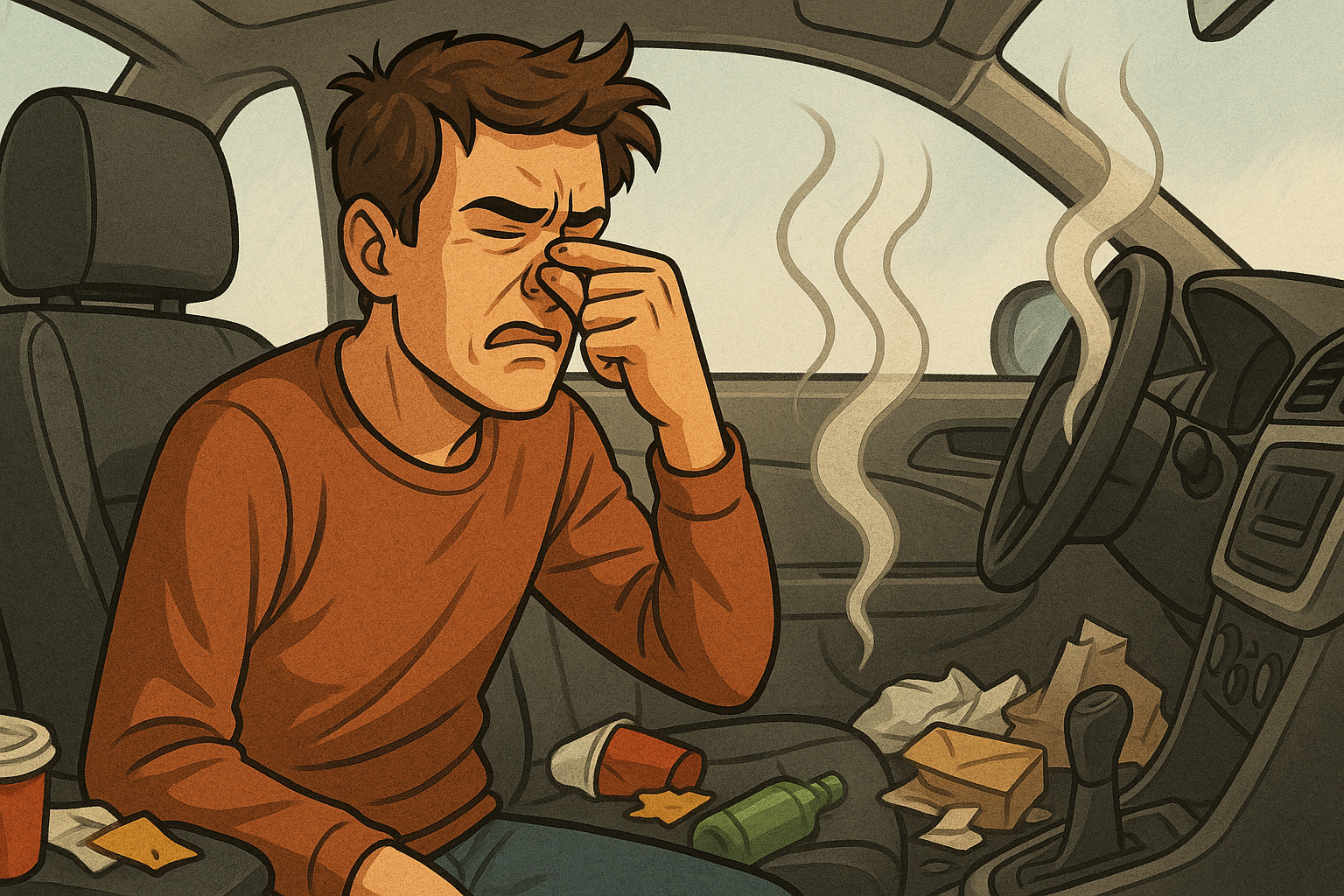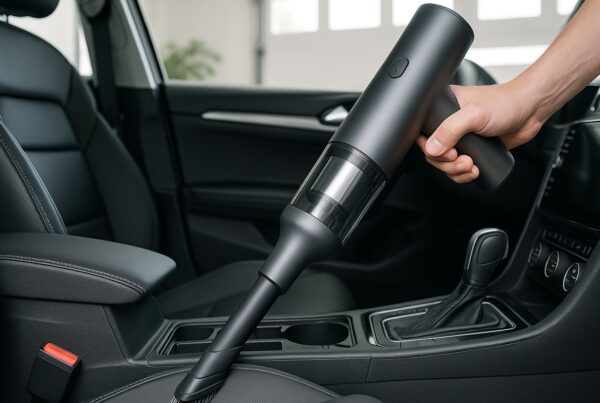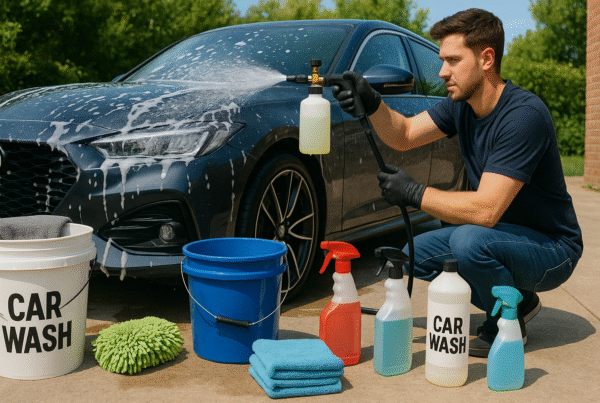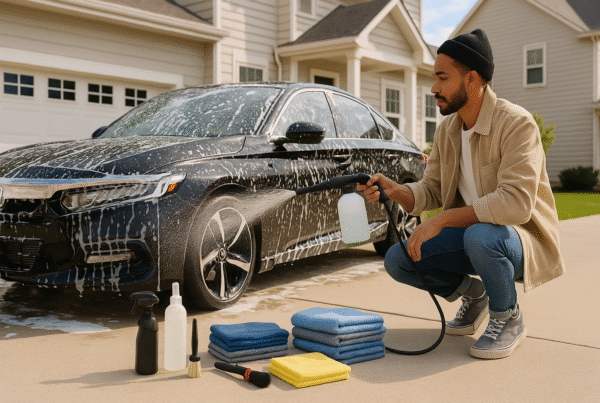Car owners often battle foul odors that seem impossible to eliminate. Forgotten gym clothes, food spills, cigarette smoke, and pet accidents create unwanted smells that stick around despite regular cleaning attempts.
The battle against stubborn car odors can be frustrating when regular air fresheners only mask the problem temporarily. But there’s good news: several solutions work well to eliminate these smells. Natural remedies like charcoal (nature’s toxin absorber) and baking soda can help. Professional treatments that use specialized tools and ozone machines offer another option. This blog will show you proven methods to get rid of those persistent smells and make your car’s interior fresh again.
Why Your Car Smells Bad: Common Culprits Behind Persistent Odors
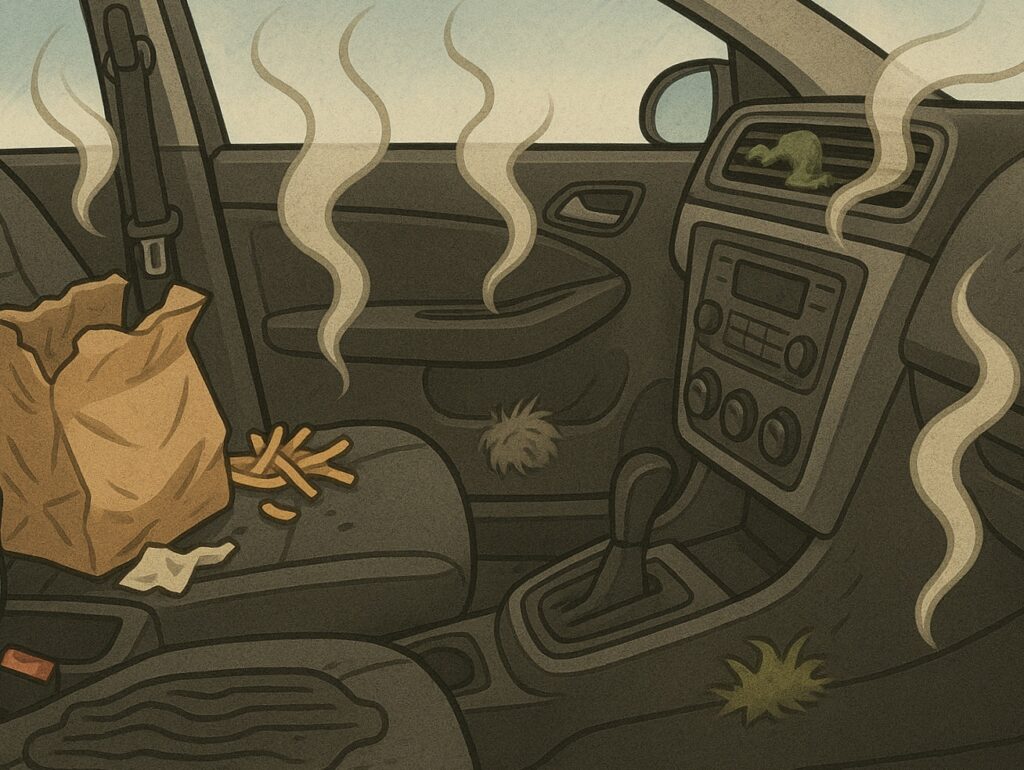
Bad smells that won’t go away in your car aren’t just annoying; they usually point to bigger problems you need to fix. Quick-fading odors are one thing, but those that stick around come from specific sources that keep making your car smell bad until you deal with them appropriately. Let me get into the most common things causing those nasty car smells and how a trusted car odor remover can help eliminate them at the source.
1. Food and beverage spills
Spilling your morning coffee or your kid’s juice box might not seem like a big deal at first. But these spills become serious stink sources when you leave them untreated. Food bits and liquids soak deep into your car’s upholstery and carpeting. It creates the perfect environment for bacteria to grow.
Here’s why food spills are such a headache:
- Decomposition process: Food starts to rot quickly, especially in hot cars, and the smell gets worse over time
- Deep penetration: Liquids soak way past the surface into padding and materials underneath
- Difficulty in complete removal: Regular cleaning tools won’t get all the leftover bits stuck in the fibers
You need to clean up even tiny spills right away. Just wiping the top of your car’s fabric won’t cut it once liquids have soaked through to deeper layers. Spilt drinks, especially milk or sweet ones, start to stink even more in the heat.
A smell that keeps coming back after you clean usually means some residue is hiding somewhere. The trunk often causes trouble, especially after you’ve carried takeout food that might have leaked sauce or oil.
2. Pet odors and accidents
Dogs make great travel buddies, but they leave behind distinct smells that aren’t easy to get rid of. Beyond the usual “dog smell” that spreads through fabric surfaces, accidents happen, especially on longer trips.
Pet smells become a real problem in tight car spaces where scents are much stronger than in open areas. Dogs fresh from swimming or playing outside bring special kinds of smells that stick to your car’s interior.
The worst pet smells usually come from accidents. Dog pee has chemicals that stick to fabric fibers. These create lasting smells that get worse if you don’t treat them properly. Your pet’s shedding hair also traps smells and spreads them all over your car.
You’ll need to find and fix the source to get rid of the smell instead of just covering it up. UV stain detectors work great to find pee spots you might miss during regular cleaning.
3. Mold and mildew from moisture
That old-sock smell coming from your vents or seats usually means you’ve got a moisture problem, causing mold and mildew. Water gets in and creates the perfect setup for these fungi to grow.
Moisture usually comes from:
- Inadequate drainage in the AC evaporator system
- Water is getting through the door seals or the sunroof channels
- Wet stuff left in the car (umbrellas, towels, floor mats)
- Spills that didn’t dry completely
Bacteria and mold grow when water collects in your AC system’s evaporator. It creates that distinct musty smell that fills up the whole car. The smell hits you hardest right after turning on your climate control.
The smell isn’t just unpleasant; mold and mildew release spores into the air that can harm your health if you breathe them for too long. Some car models tend to have more moisture problems because of how their drainage systems are built.
Poor airflow makes everything worse by trapping humidity inside. You can help prevent moisture buildup in your vents by running your AC on maximum heat for about a minute before turning off your car, especially in humid weather.
4. Cigarette smoke residue
Cigarette smoke might be the toughest car smell to get rid of. Smoke gets deep into every soft surface in your car, creating a problem that goes beyond simple cleaning. If you’re wondering how to remove cigarette odor from the car, it requires more than just a clean surface. Proper techniques and specialized treatments are necessary to tackle the deeply embedded smoke particles.
Smoke hits these spots the hardest:
- Headliner (often turns yellow from tar and nicotine)
- Upholstery and carpet fibers
- Air vents and filtration system
- Door panels and dash surfaces
The smell is so hard to get rid of because tar and nicotine build up over time. They leave a sticky coating that keeps releasing the smell. Cars with a long smoking history can smell so strong that you notice it the second you open the door.
Heat and enclosed spaces make the smoke smell even stronger, letting particles get deeper into materials even if you’ve never smoked in your car. buying a used car from a smoker means dealing with this stubborn problem.
Regular cleaning often fails to remove the cigarette smell because smoke particles get too deep for normal cleaning products to reach. The smell sticks to soft surfaces and grabs onto car upholstery fibers like nothing else.
Finding out exactly what’s causing your car’s smell is a vital first step to picking the right solution. Once you’ve identified the source, you can take targeted action to address it. If cigarette smoke is the culprit, learning how to remove cigarette odor from cars can be the key to eliminating that stubborn smell and restoring a fresh atmosphere in your vehicle.
How to Identify the Source of Car Odors
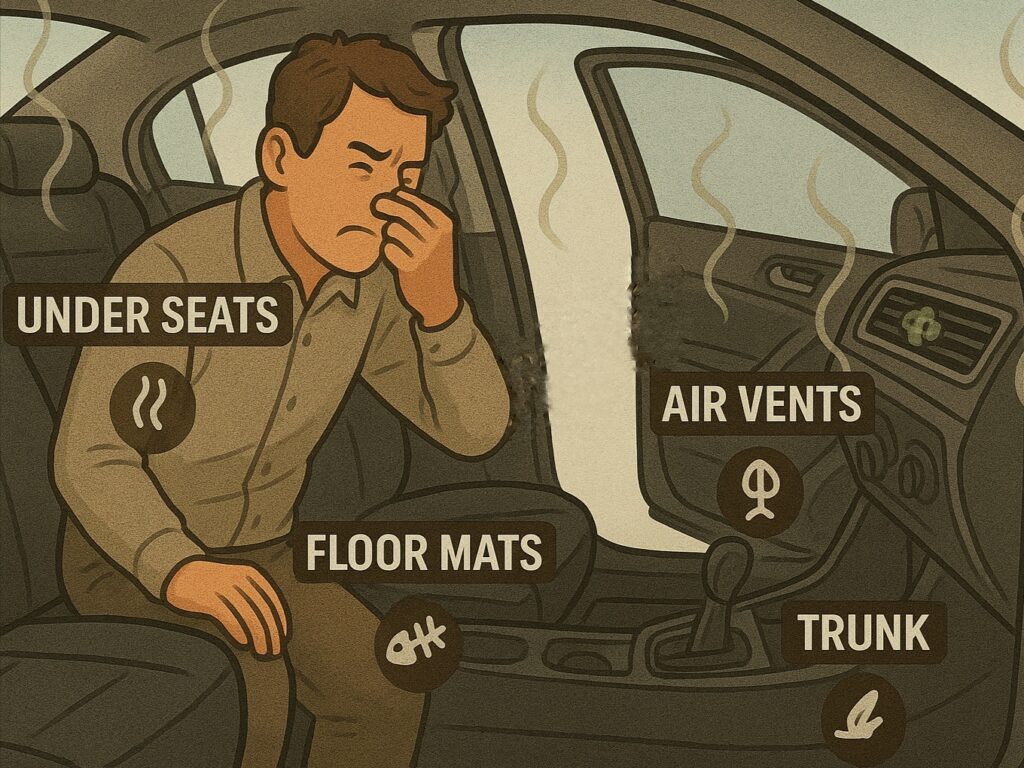
Finding the exact source of bad car smells should be your first step before using any car odor remover. You’ll waste time and money on fixes that miss the real issue without proper detection. Let me show you how to become skilled at tracking down car odors using proven methods.
1. The sniff test: Locating odor zones
The quickest way to spot car odors might surprise you: use your nose. This step-by-step method helps you zero in on where that nasty smell comes from.
Break your vehicle into zones and sniff each area systematically:
- Front cabin area: Look under seats, floor mats, dashboard, and vents
- Rear seating: Look through cushions, floor areas, and door pockets
- Cargo area: Check trunk carpet, spare tire well, and hidden compartments
“The process of elimination helps find where the smell is coming from,” notes automotive experts who recommend this approach. Watch how odors change strength as you move through different parts of the vehicle.
Timing plays a significant role here. Some smells get stronger under specific conditions, and musty odors often peak when you first start the AC, while food smells usually get worse on hot days with your car sitting in direct sunlight.
Your nose works best as your primary tool, but for challenging cases, a UV light can help spot biological stains like urine or spilt milk that you can’t see but keep making odors.
2. Common hiding spots for odor-causing materials
Stubborn odors often hide in spots we miss, even after a good cleaning. These hidden areas usually harbor smells that just won’t quit.
Here’s where smells love to hide:
- Under seats, food crumbs and spills are collected, and this creates problems since we rarely clean these spots. Floor mats catch dirt, moisture, and debris, making them major sources.
- Glove compartments might hide forgotten food that’s now decomposing. Many cars have secret storage spots that owners forget to clean.
- Sunroof drains and door seals collect moisture, creating perfect spots for mold. The evaporator in your heating and cooling system traps condensation, which leads to that classic “high school locker room” smell.
So, the cabin air filter becomes another usual suspect, especially in humid areas where mold and bacteria thrive. Make filter replacement part of your regular maintenance to prevent odors.
3. When the smell might indicate a mechanical problem
Car odors don’t always come from interior messes, and they might signal mechanical problems that need quick attention. Learning these warning scents can help you avoid getting pricey repairs later.
- A sweet, syrupy smell usually means you have a coolant leak in your vehicle’s cooling system. This smell needs immediate attention since driving could overheat your engine and cause it to fail.
- Burning rubber might point to slipping drive belts, misplaced hoses touching pulleys or brake issues. The smell of gasoline points to fuel system problems, possibly in your fuel injectors or fuel tank.
- That rotten egg smell usually means your catalytic converter isn’t converting hydrogen sulfide properly. Acrid smoke or burning oil suggests problems with your engine’s piston rings, which can hurt fuel efficiency and engine power.
- The smell of burning plastic should make you pull over right away; it might mean overheating parts or electrical problems that could start fires. Exhaust fumes in the cabin need immediate attention because of the dangers of carbon monoxide.
It’s worth mentioning that these mechanical smells aren’t just unpleasant; they’re your car’s way of sending warning signals. “Those things are your car trying to talk to you and saying, ‘Hey, I’m not healthy,'” explains an automotive expert. Quick action on these smells improves your driving experience and might save you thousands in repairs.
DIY Solutions: How to Remove Odor from Car Interiors

You can tackle car odors with simple household items instead of waiting for professional help. These DIY approaches save money and work just as well as commercial products. Here are three robust household solutions that will refresh your car’s interior.
1. Baking soda treatments for fabric surfaces
Baking soda (sodium bicarbonate) works like magic on fabric surfaces by neutralizing odors rather than just masking them. It happens because most bad smells are acidic, and baking soda’s alkaline properties help neutralize these acidic compounds.
Here’s how to remove odors with baking soda:
- Vacuum first to remove surface debris
- Check for moisture – baking soda won’t work well if you apply it to wet areas
- Sprinkle generously over dry fabric surfaces, including seats, carpets, and floor mats
- Allow to sit overnight for maximum absorption
- Vacuum the next day
“Sprinkling and hoovering up baking soda in rear- or front-facing car seats can be a quick refresh between washes to keep odors down,” according to cleaning experts. You can repeat this process several times for stubborn odors.
A helpful tip: put some baking soda under seats or in hidden areas where it will keep absorbing odors over time. You can also add a few drops of essential oil to the baking soda before application for a pleasant scent.
2. Vinegar solutions for hard surfaces
White vinegar serves as a natural odor eliminator that works great on hard surfaces throughout your vehicle. The acetic acid in vinegar kills odor-causing bacteria and neutralizes smells at their source.
Here’s a simple yet powerful vinegar-cleaning solution:
Mix equal parts distilled white vinegar and warm water in a spray bottle. This mixture works well for dashboards, plastic components, and other hard surfaces. You can increase the vinegar ratio slightly for more pungent odors.
A small bowl with about a cup of white vinegar in your car overnight, close to the smell’s source if you know it, will absorb airborne odors. The vinegar smell goes away quickly after removing the bowl and airing out the vehicle.
When you know precisely where an odor comes from (like a spill on a seat), direct application works better. Mix vinegar, water, and a couple of drops of dish soap, then clean the affected area with a damp cloth.
3. Activated charcoal for absorbing airborne odors
Activated charcoal is nature’s toxin absorber and eliminates car odors amazingly well. Unlike baking soda and vinegar, which work through chemical neutralization, charcoal physically traps odor molecules in its millions of tiny pores.
“Charcoal is widely known as nature’s toxin absorber. This is the compound that you’ll find in filters of all kinds,” note cleaning experts. Its very porous structure helps it absorb floating odors.
Here’s how to use activated charcoal:
- Put an open bag of charcoal in a central location in your vehicle
- Leave it overnight or longer for stubborn odors
- Place multiple smaller bags throughout the car for best results
- Put used charcoal in sunlight for 1-2 hours every month to rejuvenate it
Charcoal odor absorbers can stay effective for up to two years with proper care. They work great because they have no fragrance or chemicals, making them safe for use around children and pets.
These three household solutions give you budget-friendly alternatives to commercial car odor removers and tackle the most common car smell problems without harsh chemicals.
Best Car Odor Eliminator Products That Actually Work
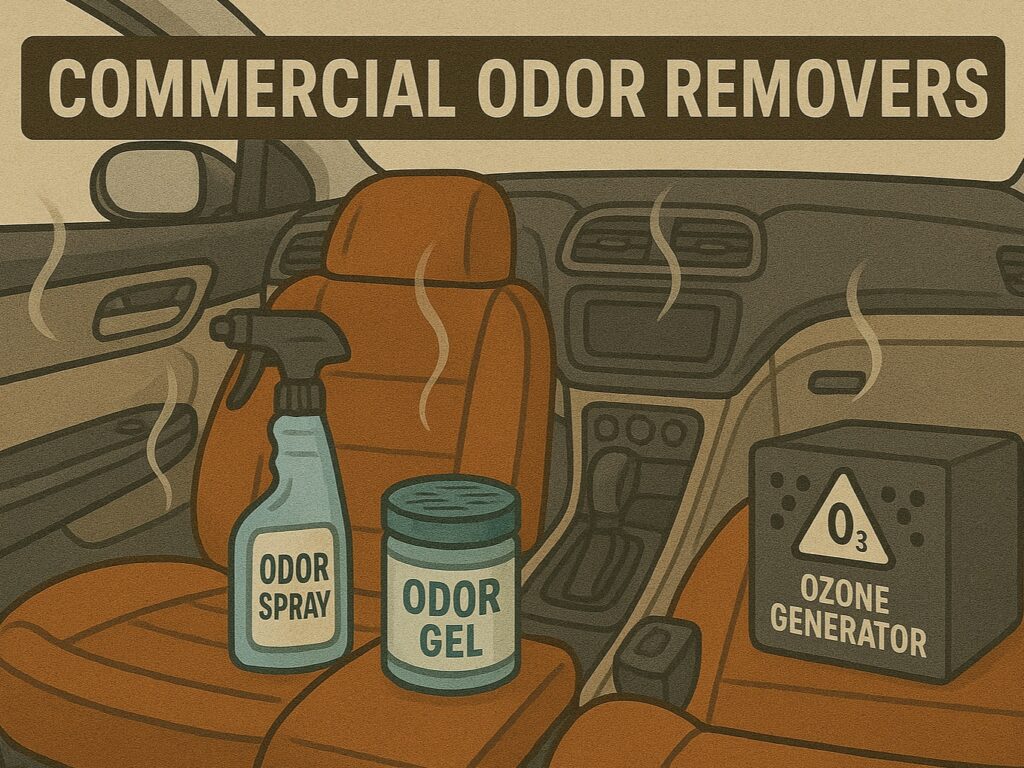
Car odors that don’t respond to DIY treatments need specialized commercial products. The right product choice depends on your specific odor issue and can help you avoid wasting time and money. Professional detailers recommend several proven solutions.
1. Sprays vs. bombs: Which works better?
The choice between spray treatments and Car odor remover bombs depends on the intensity and how you apply them. Car odor remover sprays target specific areas directly, while odor bombs use foggers to deodorize the entire cabin.
Odor bombs reach hidden spaces that other products can’t touch:
- They get into vents, under seats, and deep into upholstery fibers
- The results last longer than sprays
- Your vehicle needs to stay sealed for several hours
“Dead Scent Auto Odor Eliminator uses Chlorine Dioxide (CLO2) to eliminate odors at the molecular level rather than just masking them,” notes detailing professionals. The treatment needs at least 6 hours (overnight works best) plus an hour to air out afterward.
Car odor remover sprays offer quick treatments and handle localized odors well. You might need multiple applications for tough problems. These products help maintain freshness between deeper cleanings.
2. Enzyme-based cleaners for organic odors
Food spills, pet accidents, or biological odors need enzyme-based cleaners. These cleaners use bacteria that break down organic materials, causing bad smells.
Bio-enzymatic products like Malco’s Enzyme Cleaner contain special bacterial enzymes. “Bio-Zyme Enzyme Automotive Interior Cleaner is a specially formulated blend of bacterial enzymes that breaks down heavy organic stains, grease, and oils and removes foul odors from automotive carpets and upholstery.”
Enzyme cleaners destroy odor sources instead of covering them up. Professional detailers have a helpful tip: “Fill a syringe with Bio-Zyme Enzyme Cleaner and inject it into your cushion for maximum odor and bacteria removal.”
These products need 10-30 minutes of contact time to work. The bacteria need time to eliminate odor-causing compounds before cleaning.
3. Odor absorbers vs. air fresheners
Odor absorbers and air fresheners work differently. Absorbers remove smell molecules from the air. Air fresheners cover up smells with stronger scents.
Air fresheners add pleasant smells but don’t fix the mechanisms causing the odor. The original smell comes back once the fragrance fades.
Odor eliminators tackle the problem through different methods:
- Some change the chemical makeup of odors
- Others pull bad-smelling molecules from the air
- The best products combine both approaches
“Car odor remover bombs, also known as car odor removers, are specifically designed to neutralize and eliminate odors rather than just masking them,” explain industry experts. Many detailers use both types: an eliminator first to neutralize odors, followed by an air freshener to keep things fresh between treatments.
Your specific odor problem determines which product works best. Choose the right solution based on your situation.
How to Get Rid of Specific Car Smells
Some car odors need specialized treatment beyond basic cleaning. You’ll need targeted strategies that work for each specific type of odor. Let’s get into three of the most challenging car smells and how to tackle them effectively.
1. Removing cigarette smoke odor from car upholstery
Cigarette smoke creates one of the toughest vehicle odors. Nicotine and tar sink deep into the upholstery. Here’s what you can do:
- Use a powerful cleaner like Optimum Power Clean to break down nicotine and tar deposits on surfaces.
- Pay extra attention to the headliner since smoke residue often turns yellow.
- Clean with vapor steam treatment on fabric surfaces to release trapped smoke particles.
Cars with severe smoke damage might need extraction cleaning. A heated carpet extractor after steam treatment works wonders, even on badly stained headliners. This method shows a 90% improvement most of the time and is one of the most effective ways to remove smoke odor from car interiors that have absorbed years of residue.
2. Eliminating the musty smell in the car’s air conditioning
That sock-like smell from your vents usually means bacteria are growing in your AC system. Here’s the fix:
Condensation forms in the evaporator inside your heating and cooling system. Bacteria and mold grow when water sits there, creating that distinct musty odor.
The solution is simple. Turn your fan to low and open the windows. Spray a disinfectant like Lysol directly into the climate system’s air intake near your windshield wipers. Run the engine with the interior fan on, and the disinfectant will kill the bacteria as it moves through the system.
Take out your cabin filter before spraying so the disinfectant flows freely. It gives you a perfect chance to put in a new filter since dirty ones block airflow.
3. To Remove Gasoline Odor from the Car Carpet
Gasoline spills need quick action as the smell lingers and can be potentially hazardous. Here’s how to get rid of the gas smell:
First, find where it’s coming from: a refueling spill, leaking tank, or gas container transport. Then open all doors and windows to air out your car.
Clean the carpet by blotting excess gasoline with paper towels, then use mild soap and water with a soft brush. Baking soda works great for stubborn smells. Sprinkle it generously, let it sit overnight to absorb the odor, then hoover it up.
Natural absorbers like charcoal or coffee grounds in secured containers also do a great job neutralizing gas odors when left in the car for a few days.
Professional Odor Removal: When to Call the Experts
Professional car odor removal services provide robust solutions that tackle stubborn smells your DIY efforts can’t handle. These expert treatments use advanced equipment and techniques you won’t find at your local auto store. Here’s what you need to know about getting professional help.
1. Ozone treatment: How it works
Ozone generators create O3 molecules that break down odor-causing compounds at the molecular level. This method stands apart from regular air fresheners that mask smells. The ozone neutralizes odors by destroying their chemical makeup.
The process works because:
- Ozone reaches everywhere air flows, including vents, under seats, and deep into upholstery
- It reacts with contaminants in fabrics, surfaces, and air
- Your car gets rid of viruses, bacteria, and allergens at the same time
Professional ozone treatments take 30 minutes to 2 hours, based on how bad the smell is. Your car needs good ventilation afterward, since ozone can harm you if you breathe it in.
2. Steam cleaning for deep-seated odors
Steam cleaning uses superheated water vapor (with only 5% moisture) that gets into surfaces without damaging them. This method:
- Cleans every part of your vehicle safely, even hard-to-reach spots.
- Gets rid of deeply embedded dirt from carpets, seats, and vents.
- Eliminates bacteria, allergens, and mold spores that cause bad smells.
- Gives you chemical-free cleaning that lasts longer.
Steam cleaning works great on headliners and leather seats, especially with tough smoke odors.
3. Cost Comparison: DIY vs. professional services
Professional odor removal services vary in price:
- Basic treatments start at $100 for simple pet odors.
- Complex cases can cost up to $1,000, especially if your HVAC system needs work.
- Specific treatments like ozone ($50-60 per room) and steam cleaning ($100-800) depend on your vehicle’s size and smell intensity.
All the same, professional services are affordable in the long run because they fix the root problem instead of covering it up. DIY methods might save money upfront but could cost more if they don’t work.
Conclusion

Foul car odors can ruin even the shortest drive, but the proper car odor remover makes a big difference. Quick action is key; cleaning up spills or accidents immediately stops smells from settling deep into the fabric or vents. Everyday items like baking soda, vinegar, and activated charcoal are surprisingly effective and affordable. These natural options often work well as a car odor remover for mild to moderate smells.
However, some odors, like smoke or pet accidents, can be stubborn. That’s where professional cleaning services come in, using advanced tools and treatments to remove odors from hard-to-reach areas. Good habits also matter. Keeping your car clean, dry, and ventilated prevents most odor issues before they start. A fresh-smelling car isn’t just more enjoyable; it helps preserve your vehicle’s value in the long run.

